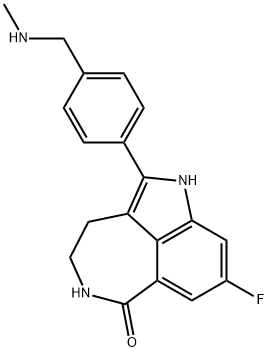283173-50-2
 283173-50-2 結(jié)構(gòu)式
283173-50-2 結(jié)構(gòu)式
基本信息
盧卡帕尼
魯卡帕尼
瑞卡帕布堿
盧卡帕尼雜質(zhì)
盧卡帕尼雜質(zhì)16
瑞卡帕布/魯卡帕尼
8-氟-2-(4-((甲胺基)甲基)苯基)-4,5-二氫-1H-氮雜卓并[5,4,3-CD]吲哚-6(3H)-酮
8-氟-1,3,4,5-四氫-2-[4-[(甲基氨基)甲基]苯基]-6H-吡咯并[4,3,2-EF][2]苯并氮雜-6-酮
8-氟-1,3,4,5-四氫-2-[4-[(甲基氨基)甲基]苯基]-6H-吡咯并[4,3,2-EF][2]苯并氮雜卓-6-酮
AG014447
AG-14447
AG 014447
Rucaparib
PF-01367388
Rucaparib Base
AG 014447
AG014447
Rucaparib impurity
Rucaparib free base
物理化學性質(zhì)
| 報價日期 | 產(chǎn)品編號 | 產(chǎn)品名稱 | CAS號 | 包裝 | 價格 |
| 2024/11/08 | HY-10617A | 魯卡帕尼 Rucaparib | 283173-50-2 | 5mg | 750元 |
| 2024/11/08 | HY-10617A | 魯卡帕尼 Rucaparib | 283173-50-2 | 10mM * 1mLin DMSO | 825元 |
| 2024/11/08 | HY-10617A | 魯卡帕尼 Rucaparib | 283173-50-2 | 10mg | 1300元 |
常見問題列表
|
PARP-1 1.4 nM (Ki) |
Rucaparib is the most potent PARP inhibitor in enzyme assays (K i , 1.4 nM), and a possible?N-demethylation metabolite of AG14644. The radio-sensitization by Rucaparib is due to downstream inhibition of activation of NF-κB, and is independent of SSB repair inhibition. Rucaparib could target NF-κB activated by DNA damage and overcome toxicity observed with classical NF-κB inhibitors without compromising other vital inflammatory functions. Rucaparib inhibits PARP-1 activity by 97.1% at a concentration of 1 μM in permeabilised D283Med cells.
Rucaparib and AG14584 significantly (P < 0.05) increases temozolomide toxicity. Rucaparib (1 mg/kg) significantly increases temozolomide-induced body weight loss.?Rucaparib (0.1 mg/kg) results in a 50% increase in the temozolomide-induced tumor growth delay. Rucaparib is not toxic but significantly enhances temozolomide-induced TGD in the DNA repair protein-competent D384Med xenografts. Pharmacokinetics studies also show that Rucaparib is detected in the brain tissue, which indicates that Rucaparib has potential in intra-cranial malignancy therapy. Rucaparib significantly potentiates the cytotoxicity of topotecan and temozolomide in NB-1691, SH-SY-5Y, and SKNBE (2c) cells. Rucaparib enhances the antitumor activity of temozolomide and indicates complete and sustained tumor regression in NB1691 and SHSY5Y xenografts.
